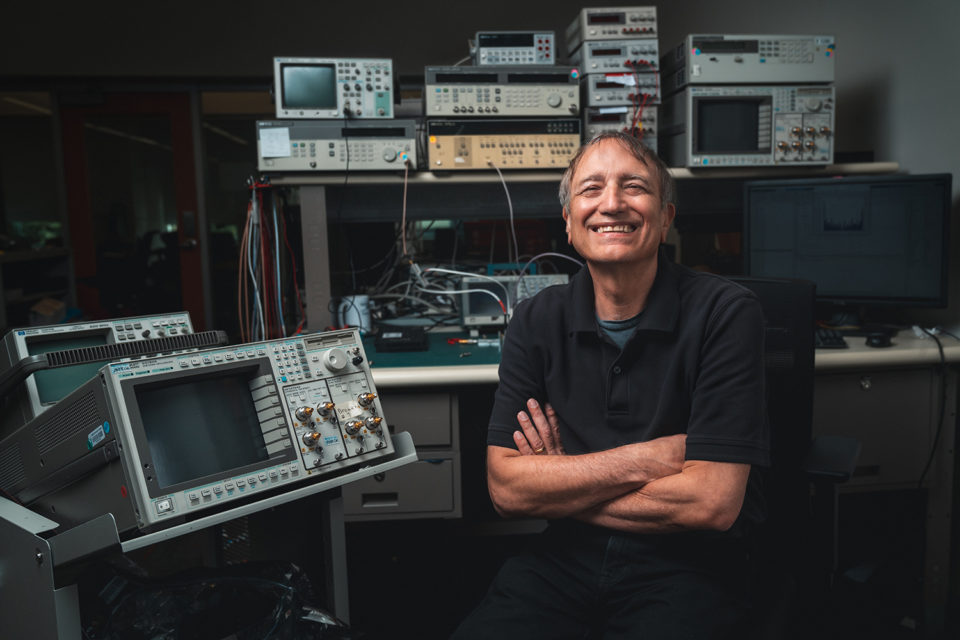

Stanford computer scientist and engineer Patrick M. “Pat” Hanrahan is co-recipient of the 2019 Turing Award. (Image credit: Andrew Brodhead)
In recognition of his “revolutionary impact” on computer-generated animation, Stanford computer scientist and engineer Patrick M. “Pat” Hanrahan will share the 2019 Turing Award from the Association of Computing Machinery (ACM) – often described as the “Nobel Prize” of computing.
“The announcement came totally out of the blue and I am very proud to accept the Turing Award,” said Hanrahan, who is the Canon Professor in the School of Engineering and a professor of computer science and of electrical engineering at Stanford University. “It is a great honor, but I must give credit to a generation of computer graphics researchers and practitioners whose work and ideas influenced me over the years.”
Hanrahan splits the award and its $1 million prize with one-time mentor and colleague Edward “Ed” Catmull, former president of Pixar and Disney Animation Studios. The pair’s recognition marks only the second time that the award has been given for computer graphics.
“All of us at Stanford are tremendously proud of Pat and his accomplishments, and I am delighted that he and his colleague Ed Catmull are being recognized with the prestigious Turing Award,” said Stanford President Marc Tessier-Lavigne. “Pat has made pioneering contributions to the field of computer graphics. His work has had a profound impact on filmmaking and has created new artistic possibilities in film, video games, virtual reality and more.”
In the late-1980s, Hanrahan was chief architect at Pixar under Catmull, where he was principally responsible for creating the now-famous RenderMan Interface, the 3D animation application used to make such beloved films as Toy Story, Finding Nemo, Cars and many more. RenderMan is still widely used today. Hanrahan is particularly proud of his work on RenderMan’s Shading Language, which brought dramatic, photorealistic lighting to computer animation for the first time. He has won three Academy Awards for technical achievement.
“Pat Hanrahan’s work is an extraordinary example of the kind of creative research for which Stanford Engineering is known,” said Jennifer Widom, dean of the Stanford School of Engineering and a colleague of Hanrahan’s in the departments of computer science and of electrical engineering. “His work on computer graphics and data visualization have transformed industries and fields, and I am thrilled he is receiving this recognition, which he so richly deserves.”
In a statement, ACM said Hanrahan and Catmull “fundamentally influenced the field of computer graphics through conceptual innovation and contributions to both software and hardware. Their work has had a revolutionary impact on filmmaking, leading to a new genre of entirely computer-animated feature films.”
Early days at Pixar
Hanrahan joined Pixar in 1986, soon after Steve Jobs purchased the company from George Lucas’s Lucasfilm, where Catmull was working at the time. In their roles at Pixar, Hanrahan and Catmull set in motion a revolution in computer-generated animation that has become the heart of one of the most prominent branches of filmmaking today – computer animation. According to ACM, Hanrahan created nothing less than a “new art form.”
Hanrahan left Pixar to join the faculty at Princeton University in 1989. He joined Stanford in 1994, where his continued work has shaped computer graphics for the last quarter century. “I wanted to return to a university to do longer-term research, and I wanted to try my hand at teaching computer graphics,” Hanrahan said of his decision to enter academia. “At the time there were few professors who specialized in computer graphics.”
When starting this endeavor, Hanrahan did not think the technology would advance enough in his lifetime to make a full-length computer-generated movie. “I didn’t think it would be possible to create imagery that people believed was real without advances in artificial intelligence,” Hanrahan said. Catmull persevered, however, and Toy Story was released in 1994.
While at Stanford, Hanrahan pioneered many new techniques in computer graphics, including “physically based rendering,” a way of modeling light sources and materials and then simulating the process of light interacting with them in a virtual scene. Hanrahan has taught the course CS348b: Computer Image Synthesis, since his arrival at Stanford; this led to a book on the topic, titled Physically Based Rendering: From Theory to Implementation, written by his former graduate students Matt Pharr and Greg Humphreys. The book explains how to implement a ray tracer using “literate programming,” a technique invented by Donald Knuth, another Turing laureate from Stanford.
“Stanford is just an unbelievable atmosphere of interdisciplinary expertise,” says Hanrahan, who just finished mentoring his 40th PhD student. “We’re able to do things that nobody else could do because of that environment.”
The coolest thing in the world
Hanrahan’s handiwork not only transformed filmmaking but would prove foundational to the computer gaming industry and lead to his development of Tableau, a data visualization application that has impacted business, scientific, engineering and medical analytics.
All in all, it is been a tremendous run for the unassuming Hanrahan. Not a bad life’s work for a guy whose PhD is in biophysics and who started out in neurobiology trying to model the motor systems of nematode worms. Hanrahan said that early work felt very abstract until his roommate introduced him to computer graphics and suggested turning the numbers and concepts into images.
“I thought the idea that we could turn abstract concepts, math and algorithms into images was the coolest idea in the world,” he recalled. “So I started reading about computer graphics.”
Computer graphics was a small world back then. There were only a handful of researchers doing cutting-edge work. Hanrahan quickly found his way to Ed Catmull – and the rest is history.
Stanford 3D computer graphics pioneer Pat Hanrahan wins $1M Turing Award - by Andrew Myers - Stanford News - March 18th, 2020


